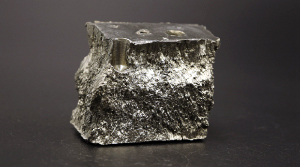
Ytterbium(Yb) is the one of the lanthanide elements with an atomic number 70. Ytterbium is a bright, soft, silvery-white rare earth metal. Malleability and ductility are also two properties of ytterbium metal. Due to ytterbium is a little electropositive element, it slowly reacts water resulting in ytterbium hydroxide. Ytterbium reacts with all halogens. +2 oxidation state is the basis of the relative stability, but ytterbium, as other rare earth metals, usually has +3 oxidation state in most compounds. The discovery of ytterbium was made in Geneva, Switzerland by Swiss chemist Jean Charles Galissard de Marginac in 1878. The name comes from the name of Swiss village Ytterby. 1937 is year when ytterbium metal was purified by Klemm and Bonner by heating ytterbium chloride with potassium. In 1953 the pure ytterbium was produce at th Ames laboratory from which both physical and chemical properties could be measured. The commercial source of ytterbium is monazite mineral. However, ytterbium also exists in other minerals as well. Like other rare earth metals ytterbium is separated by ion-exchange and solvent extraction techniques. The price of ytterbium in 1998 was about $1000 per kilogram.
Applications of Ytterbium:
Ytterbium is used as radiation source in portable X-ray machines which emits gamma rays which could pass through soft tissues of the body. However, this gamma ray is blocked by dense materials like bone.
Ytterbium is used in nuclear medicine
Ytterbium is used in ticking clocks since these clocks hold the record for stability
Ytterbium is used as dopant because it improves the grain strength and refinement. In addition, it may improve some mechanical properties of stainless steel
Ytterbium is used to mix with other metal resulting in alloys which are used in dentistry
Ytterbium is used as dopant in solid state lasers and double clad fiber lasers, since ytterbium has long lifetimes, ability to generate short pulses and is highly efficient
Ytterbium is used when there is need to increase electrical resistivity
https://nanografi.com/rare-earth-materials/yb-ytterbium-powder-325-mesh-99-5/
Comments
Post a Comment